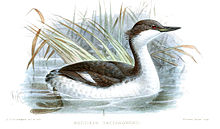Junin flightless grebe
| Junin grebe | |
|---|---|
 |
|
| Scientific classification | |
| Kingdom: | Animalia |
| Phylum: | Chordata |
| Class: | Aves |
| Order: | Podicipediformes |
| Family: | Podicipedidae |
| Genus: | Podiceps |
| Species: | P. taczanowskii |
| Binomial name | |
|
Podiceps taczanowskii (Berlepsch & Stolzmann, 1894) |
|
The Junín grebe, Junin flightless grebe or puna grebe (Podiceps taczanowskii) is a grebe found only on Lake Junin in the highlands of Junín, west-central Peru. The grebe generally breeds in bays and channels around the endge of the Lake, within 8–75 m (26–246 ft) of reed beds, entering the reeds only for nesting or roosting. When not breeding, Junin grebe prefer open water, moving far out from lake shores. The current population is estimated at less than 250.
The scientific name commemorates the Polish zoologist Władysław Taczanowski, author of Ornithology of Peru (1884–86).
Another highly endangered species, the Junin rail, is restricted to the same lake.
With a size of approximately 35 cm, the Junin grebe has a dark grey crown extending down the back of its neck to a black back. It has white lower parts of the face, neck and underparts, with a narrow grey bill. Perhaps the most striking feature is its bright red eyes. On the side of the head of adults there are silvery grey feathers, which are absent on non-breeding adults and juveniles.
Its calls include melodic whistles doo’ ith, wit, and a longer phooee-th when trying to attract a mate.
The Junin grebe’s exceptional diving skills allows it to feed on small fish and invertebrates. They can be often seen feeding and diving simultaneously in small groups.
Courtship involves two grebes facing breast to breast and turning their head quickly from side to side, called ‘head-shaking’. The nests of Junin grebes are built in reed beds around the border of Lake Junin, and a typical clutch size is two eggs, laid in December or January. In years when the water level of the lake is particularly low, no young are raised.
Junin grebes are endemic to Lake Junin, in west-central Peru. The lake covers approximately 140 km2 and at its deepest is 10m deep, although most of the lake is less than 5m deep. Around the borders of the lake are substantial reed marshes, where the grebes nest and roost.
Large fluctuations in water levels, caused by a nearby hydroelectric plant, and water pollution from mining activities have caused the population of grebes to fall from 1000 in 1961 to around 200 in 2007. Contamination of the lake from mining waste products kills the small fish that are the Junin grebes main source of food. The hydroelectric plant can cause the water level to drop below 5m, which prevents the birds from raising chicks, and can cause damage to the bordering reed marshes.
...
Wikipedia

